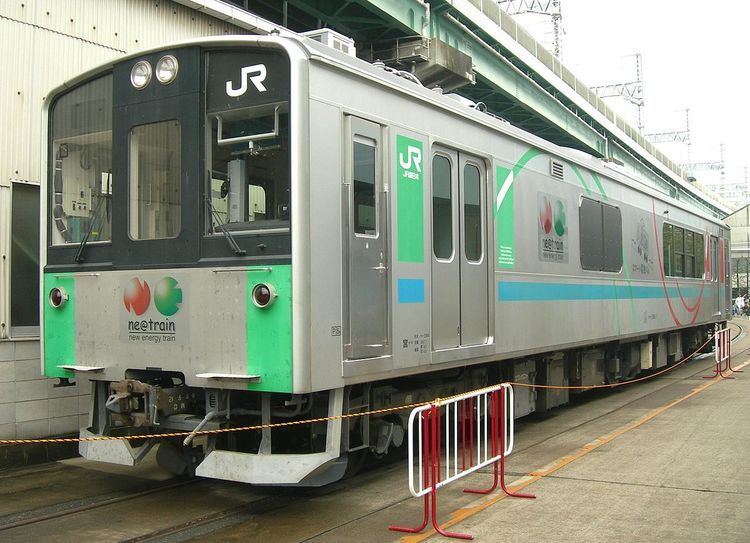In service 2003–Present Constructed 2003 Formation Single car | Manufacturer Tokyu Car Corporation Number built 1 vehicle Operator(s) JR East | |
 | ||
The "NE Train" (NEトレイン) (New Energy Train) is an experimental railcar which has been used to test a number of alternative power sources by the Railway Technical Research Institute (RTRI) and East Japan Railway Company (JR East) in Japan since 2003.
Contents
KiYa E991 diesel/battery hybrid railcar
The "NE Train" was first delivered from Tokyu Car Corporation in April 2003, configured as the world's first hybrid diesel/battery railcar and classified as KiYa E991-1. The stainless steel bodyshell was derived from the E127-100 series EMU design, with cabs at either end and no gangways. From 6 May 2003, it was tested on the Nikkō and Karasuyama Lines. Data obtained from these trials was used to develop the KiHa E200 DMU, which entered service on the Koumi Line from July 2007.
KuMoYa E995 fuel-cell/battery hybrid railcar
The "NE Train" underwent modifications in 2006 to replace the diesel generator with a hydrogen fuel cell, becoming the world's first fuel-cell/battery hybrid railway vehicle, classified KuMoYa E995-1. The vehicle was fitted with six hydrogen tanks (with total capacity of 270 l) and lithium-ion batteries with increased storage capacity (19 kWh) compared with the earlier KiYa E991 hybrid version. These powered two 95 kW traction motors. The railcar was based at Nagano depot, and tested on JR East main lines in the Nagano area during fiscal 2007 at speeds of up to 100 km/h.
KuMoYa E995 series battery railcar
The "NE Train" again underwent modifications at Tokyu Car Corporation's factory in Yokohama in 2009 to become a battery electric multiple unit with the addition of a pantograph and storage batteries replacing the earlier fuel cell, and rebranded "NE Train Smart Denchi-kun" (NE Train スマート電池くん). This railcar has a maximum service speed of 100 km/h (60 mph) and can operate on battery power alone a distance of up to 50 km away from an overhead power supply.
The railcar was test-run within Ōmiya Works from October 2009, with test running on the Utsunomiya Line under consideration from January 2010.
The unit was modified in August 2011, with one of the four lithium battery units relocated beneath the passenger seats, increasing available space.
In February and March 2012, the programme entered its final phase, with night-time test-running on the non-electrified Karasuyama Line outside operating hours. A recharging facility was built at Karasuyama Station at the end of the line, consisting of a rigid overhead conductor enabling the train to be recharged via its pantograph. The overhead conductor bar is electrified at 1,500 V DC, powered from the local electricity grid 6.6 kV AC supply, and a 10-minute charge allows the train to travel approximately 20 km (12 mi).
Technology developed in the "Smart Denchi-kun" programme was incorporated in the EV-E301 series two-car battery electric multiple unit that entered revenue service on the Karasuyama Line and Tohoku Main Line from March 2014.
